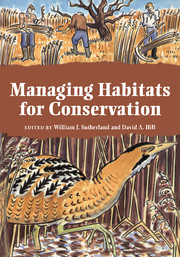Book contents
- Frontmatter
- Contents
- List of Contributors
- Acknowledgements
- 1 Introduction and principles of ecological management
- 2 Site management planning
- 3 Access
- 4 Coastal habitats
- 5 Rivers, canals and dykes
- 6 Waterbodies
- 7 Reedbeds, fens and acid bogs
- 8 Grasslands
- 9 Farmland
- 10 Lowland heathland
- 11 Upland moors and heaths
- 12 Woodland and scrub
- 13 Urban areas
- Some useful addresses
- Index of species by common names
- Subject index
3 - Access
Published online by Cambridge University Press: 05 February 2015
- Frontmatter
- Contents
- List of Contributors
- Acknowledgements
- 1 Introduction and principles of ecological management
- 2 Site management planning
- 3 Access
- 4 Coastal habitats
- 5 Rivers, canals and dykes
- 6 Waterbodies
- 7 Reedbeds, fens and acid bogs
- 8 Grasslands
- 9 Farmland
- 10 Lowland heathland
- 11 Upland moors and heaths
- 12 Woodland and scrub
- 13 Urban areas
- Some useful addresses
- Index of species by common names
- Subject index
Summary
Introduction
In recent years there has been a growing interest in outdoor recreation, ‘green’ tourism and wildlife conservation. This has resulted, in turn, in an increase in the number of people visiting the countryside in general and reserves in particular, and a growing awareness among conservation organisations of the need to accommodate these interests by providing easy access to reserves. There is no better way to excite and interest people in wildlife and the countryside than through first-hand experience. Reserves provide invaluable opportunities to educate and inform the public concerning nature and nature conservation. However, visitors to reserves are also a potential cause of considerable habitat damage and disturbance and the provision and management of access to sites requires careful planning.
The first stage in considering ‘access management’ on a reserve is to decide whether access should be encouraged at all and if so to what extent? This will be determined by the degree to which the nature conservation value of the site may be put at risk by increasing levels of human disturbance. The major concern is physical damage to plant communities and disturbance to breeding or feeding birds or mammals. For birds, human-induced disturbance during the breeding season may lead to nest desertion and increased predation or, outside the breeding season, to a reduction in the level of foraging activity and ultimately the use of a site. The need to prevent access completely to a site is unusual except perhaps in the case of fragile plant communities such as raised peatland bogs where a footprint on the Sphagnum surface may take 20–30 months to disappear. In practice it is almost always possible, through careful site layout and design, to provide for access without damaging the conservation value of a site.
- Type
- Chapter
- Information
- Managing Habitats for Conservation , pp. 42 - 58Publisher: Cambridge University PressPrint publication year: 1995
- 4
- Cited by



